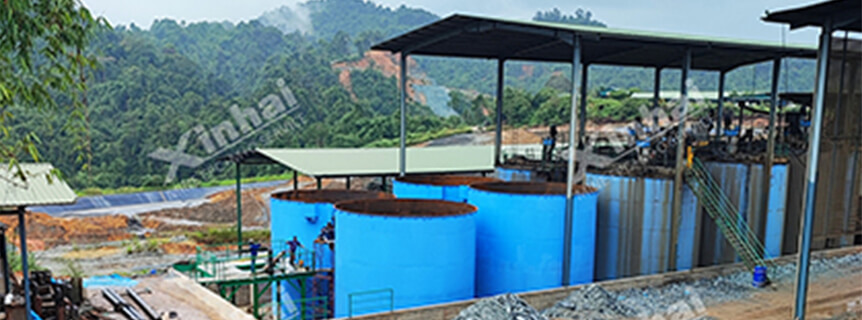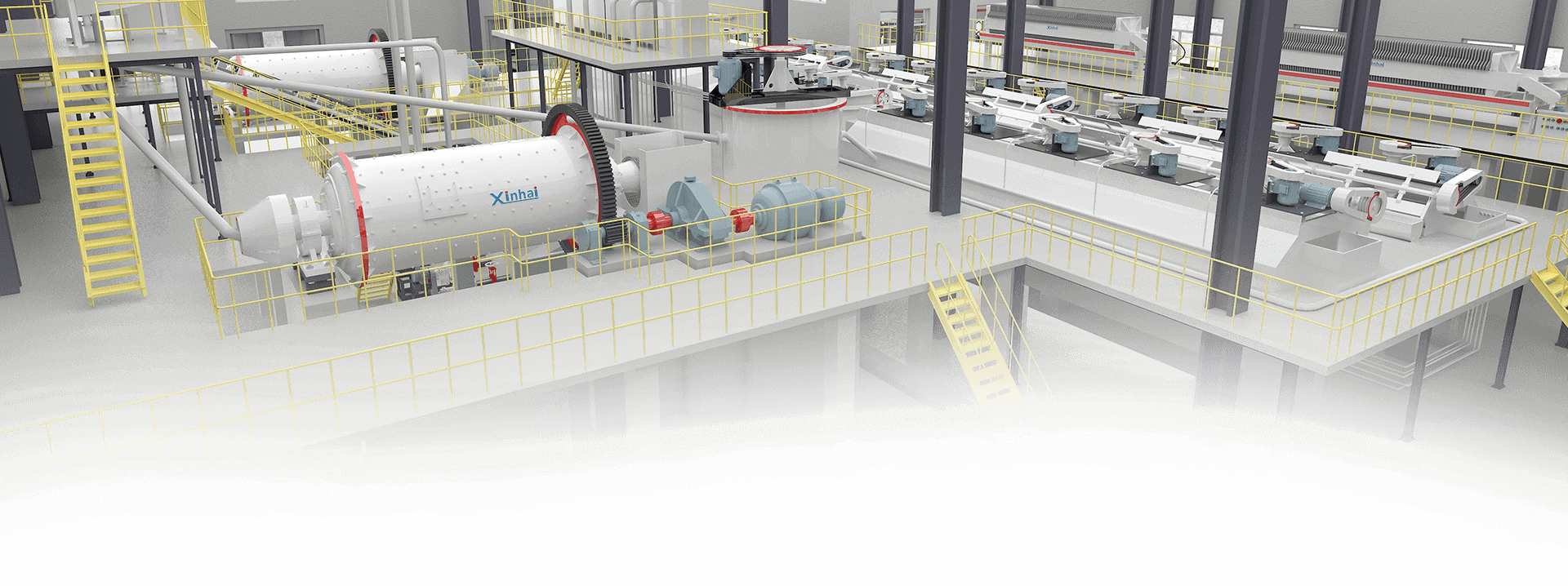Cyanide Leaching in Gold Beneficiation: Pros and Cons
 Laura
Laura
 Sep 23, 2025
Sep 23, 2025
 1015
1015
If you want to know more details about equipment, solutions, etc, please click the button below for free consultation, or leave your requirements!

( 800tpd CIL gold mine )
Cyanide leaching is one of the most common methods for extracting gold from ore bodies and gold-bearing rock. In the context of gold beneficiation, cyanide leaching is often preferred for its ability to recover even fine gold particles. While highly effective, the use of cyanide in gold mining comes with its share of controversy due to environmental and safety concerns.
In this article, we'll delve into the pros and cons of using cyanide leaching in gold beneficiation, exploring both the benefits and challenges of this widely used extraction method.
01 What Is Cyanide Leaching in Gold Beneficiation?
BackCyanide leaching is a process used to extract gold from its ore by dissolving it in a cyanide solution. The process typically involves grinding the ore into a fine powder, then treating it with a cyanide solution, which dissolves the gold into a soluble form. The gold is then recovered from the solution using various methods, such as carbon-in-pulp (CIP), carbon-in-leach (CIL), or zinc precipitation.
This method is widely used because it is highly efficient at extracting gold from low-grade ore, making it essential in the modern gold mining industry.
02 How Does Cyanide Leaching Work?
BackCyanide leaching involves several steps:
Crushing and Grinding: The ore is crushed and ground into fine particles to increase the surface area for cyanide to work effectively.
Cyanide Solution Application: The finely ground ore is mixed with a cyanide solution, which dissolves the gold. The gold then becomes soluble as a gold-cyanide complex.
Gold Recovery: The gold is separated from the cyanide solution using methods like activated carbon or zinc precipitation.
Refining: The recovered gold is then refined into a pure form.
Cyanide leaching is particularly effective for low-grade ores that would otherwise be uneconomical to process using traditional methods.
03 Pros of Cyanide Leaching in Gold Beneficiation
Back1. High Gold Recovery Rates
One of the most significant advantages of cyanide leaching is its high gold recovery rate. It's capable of extracting gold from ores with gold concentrations as low as 0.5 grams per ton, making it ideal for low-grade deposits.
2. Cost-Effectiveness
Cyanide leaching is one of the most cost-effective gold extraction methods, particularly when compared to older methods like amalgamation or mercury-based extraction. The relatively low cost of cyanide and its widespread availability makes it a practical choice for commercial mining operations.
3. Ability to Extract Fine Gold
Cyanide leaching is effective at extracting fine gold particles that may be missed using traditional gravity separation techniques. This makes it especially useful for processing gold ores that contain a high proportion of fine or microscopic gold.
4. Proven and Established Technology
Cyanide leaching is a well-established, proven technology that has been used for over a century in gold extraction. Its effectiveness and reliability make it a preferred choice in the industry, especially for large-scale gold mining operations.
5. Efficient for Large-Scale Mining
For large-scale commercial mining, cyanide leaching is highly efficient. It allows for the extraction of gold from vast amounts of ore, significantly boosting the economies of scale in the gold mining process.
04 Cons of Cyanide Leaching in Gold Beneficiation
Back1. Environmental Impact
The most significant disadvantage of cyanide leaching is its potential environmental impact. Cyanide is toxic to both humans and wildlife, and improper disposal of cyanide waste can lead to pollution of soil, water sources, and surrounding ecosystems. The threat of cyanide spills or leakages from mining sites has raised environmental concerns for decades.
2. Health and Safety Risks
Cyanide is a highly toxic substance, posing serious health risks to workers and local communities if mishandled. Exposure to cyanide, either through inhalation or direct contact, can lead to poisoning and even death. This requires rigorous safety protocols and safety measures during mining operations.
3. Regulatory Challenges
Because of its toxicity, the use of cyanide is heavily regulated in many countries. Miners must comply with strict environmental regulations and must implement cyanide management plans to minimize environmental harm. Regulatory bodies often require cyanide destruction processes to ensure that no cyanide waste is left in the environment after mining operations are complete.
4. Requires Large Amounts of Water
Cyanide leaching requires substantial quantities of water to process the ore and carry out the leaching process. In areas with water scarcity, this can put significant pressure on local water resources, potentially leading to conflicts with local communities or other industries.
5. Toxicity of Residual Waste
The cyanide-laden tailings left after gold extraction are often stored in tailings ponds or impoundments. If these containment areas fail, there is a risk of cyanide runoff contaminating nearby water supplies. The long-term storage of cyanide waste remains an ongoing environmental challenge.
05 How to Mitigate the Risks of Cyanide Leaching
BackWhile cyanide leaching has its drawbacks, many companies are working to mitigate its risks through advanced technologies and safer practices:
1. Cyanide Destruction
Modern cyanide leaching operations often use methods like sulfur dioxide and air or hydrogen peroxide to destroy cyanide after gold recovery. This ensures that the residual cyanide is broken down into non-toxic by-products before disposal.
2. Tailings Management
To reduce environmental harm, tailings ponds and storage facilities must be carefully monitored and maintained. Many mining operations now use lined tailings ponds and cyanide detoxification techniques to ensure that cyanide doesn't leach into the surrounding environment.
3. Alternative Cyanide-Free Technologies
Research into cyanide-free gold extraction methods, such as thiosulfate and glycine-based solutions, is ongoing. These alternatives could potentially provide safer, environmentally friendly options for gold mining in the future.
Maybe you want to learn more about CNLITE eco-friendly gold leaching reagent, which can 100% take place of sodium cyanide for gold processing and refining, including gold CIP, CIL, heap leaching, pool leaching and other cyanide process.
06 Frequently Asked Questions (FAQs)
Back❓ Why is cyanide used in gold mining?
Cyanide is used in gold mining because it is highly effective at dissolving gold from ore, even in low-grade deposits. It enables the extraction of gold that would otherwise be difficult or impossible to recover with traditional methods.
❓ Is cyanide leaching safe for the environment?
Cyanide leaching can be safe for the environment if managed correctly. However, improper handling or disposal of cyanide waste can result in significant environmental damage. Modern mining operations must adhere to strict environmental regulations to minimize these risks.
❓ What alternatives to cyanide are being developed for gold mining?
Several alternatives to cyanide leaching are being researched, such as thiosulfate and glycine-based gold extraction methods. These alternatives aim to offer safer and more sustainable solutions for gold extraction.
Maybe you want to learn more about CNLITE eco-friendly gold leaching reagent, which can 100% take place of sodium cyanide for gold processing and refining, including gold CIP, CIL, heap leaching, pool leaching and other cyanide process.
07 Conclusion
BackCyanide leaching remains the gold extraction method of choice for many commercial mining operations due to its efficiency, cost-effectiveness, and ability to extract gold from low-grade ores. However, its use comes with significant environmental and safety concerns, especially related to toxic waste and the risk of contamination.
For gold miners, weighing the pros and cons of cyanide leaching is crucial to ensuring that their operations are both economically viable and environmentally responsible. Ongoing advancements in cyanide destruction techniques and alternative extraction methods offer hope for minimizing the harmful effects of cyanide leaching in the future.
Feel free to contact us and learn more about gold cyanide leaching!
 +86 183 3575 8886
+86 183 3575 8886 pinklaurabao@gmail.com
pinklaurabao@gmail.com




 Message
Message Chat Now
Chat Now

















